Some of the links in this post may be affiliate links.
Peperomia prostrata, commonly known as String of Turtles, is a delightful, easy to care for species in the Peperomia genus. Some other common names include Turtle Vine, Chain of Turtles, and Jade Necklace. This native of Ecuador is a trailing species with small, round and succulent leaves and is a perfect plant for smaller spaces.
Like the common name suggests, the leaf pattern of String of Turtles is reminiscent of turtle shells. It has a vining habit and forms a beautiful, lush mat of foliage and is perfect for smaller hanging baskets or to trail down from a shelf.
Keep reading to learn all about how to care for this dainty species!
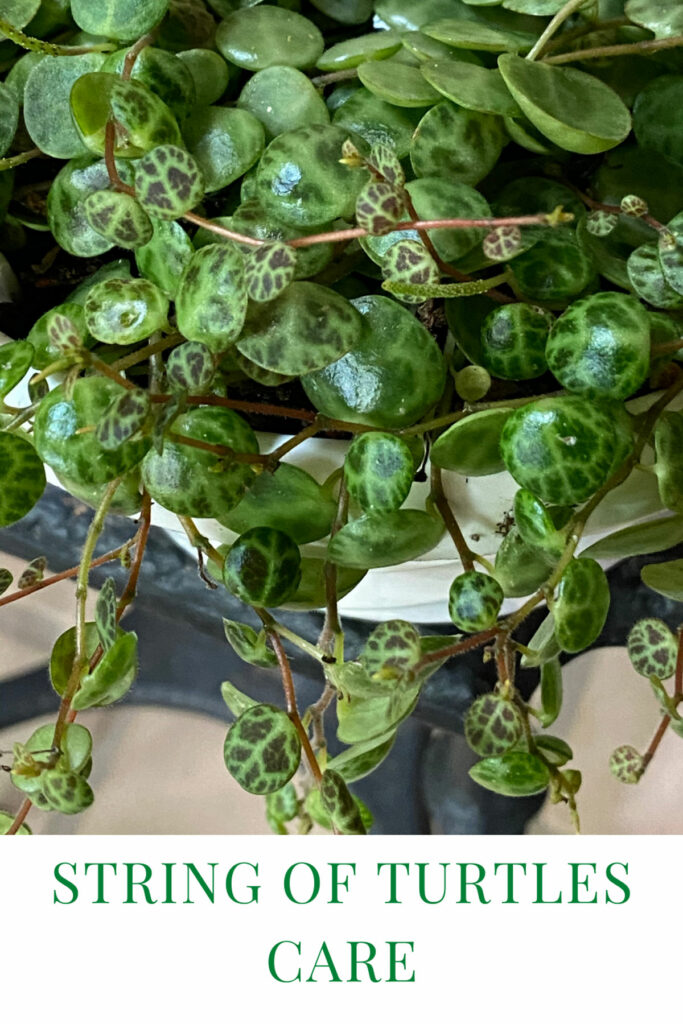
Table of Contents
STRING OF TURTLES CARE TIPS & GROWING CONDITIONS
1. LIGHT
Place your String of Turtles immediately in front of a nice, bright window that gets mostly indirect light. Providing your plant with 2-3 hours of direct sun is very beneficial, but avoid all day full sun.
At a bare minimum, it should be immediately in front of a northern facing window (if you live in the Northern hemisphere) or in front of a southern facing window (if you live in the Southern hemisphere).
Regardless where you live, for best growth, East or West facing windows would be ideal for these plants.
2. WATER
Watering is a very important topic to get right with Peperomias since most of them have pretty thick, succulent leaves, and Peperomia prostrata is no exception.
It is important to always water thoroughly, but you should allow at least the top half of the potting mix to dry out before watering again.
If your potting mix has stayed too wet for too long (“overwatered” as many people call it, but I despise the term!), you may notice one of 3 things:
- The first is that your plant can wilt. Keep in mind that wilting can also result from the potting mix having gone completely dry. You will have to feel your potting mix to determine which it is. Do not use a soil moisture meter as they are notoriously unreliable and drive the wrong behavior.
- The second thing that can happen with potting mix that has stayed wet for too long is that your plant can exhibit symptoms of edema (sometimes spelled oedema). These include raised bumps or protrusions on the leaves.
- The third thing is that your String of Turtles’ relatively fragile stems can rot pretty easily.
To be completely safe, allow 1/4 to 1/2 of your potting mix to dry out and then water thoroughly until water escapes the drainage hole.
It is also important to get the potting mix right for this plant so keep reading to learn my special mix for Peperomia.
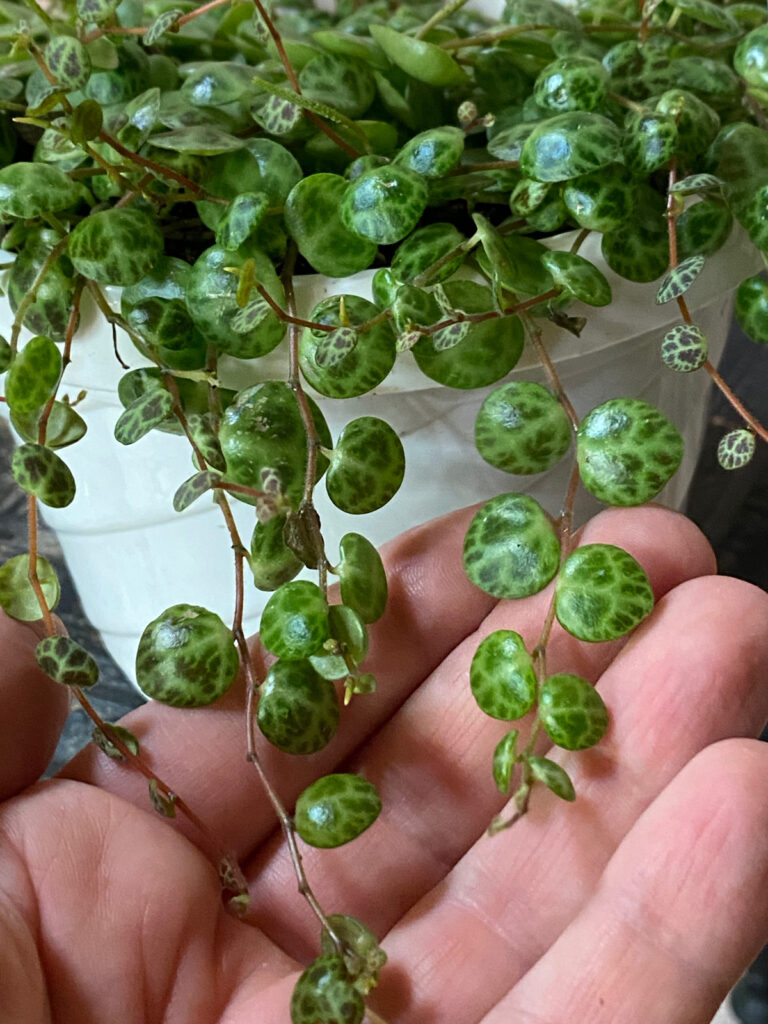
3. FERTILIZING
My go-to fertilizer for most of my houseplants, including all Peperomia species, is Dyna-Gro Grow. It is a urea-free fertilizer and unlike many on the market, contains ALL of the macro and micro nutrients that plants needs for good growth.
I’ve used Dyna-Gro Grow for years now and the results are wonderful! Fertilizing should be a important part of any houseplant care routine so make sure to get yourself some and try it out for yourself.
Click below to get your own, and you will not be disappointed!
If your plant has been growing well in a nice, bright location and looks good, but the pattern and color of your leaves has faded, it could be due to a lack of fertilization. I also find that the older foliage will not have as many distinct markings.
4. SOIL & REPOTTING
Peperomia prostrata, like any any Peperomia species, is very sensitive to potting mixes that stay too wet or that have poor drainage.
You’ll also want to be aware that you should not over-pot these plants by any means. By giving this plant a pot that is much larger than its previous pot, the potting mix will take a lot longer to dry out, and it may spell death.
String of Turtles likes to remain at least slightly root-bound. If your plant is very root-bound, only go up by one pot size (for example, from a 4 inch pot to a 6 inch pot and no larger).
This plant probably will never need to be in a pot that’s larger than 6″ in diameter and can stay in this size pot for quite a number of years!
The following is my potting mix recipe for Peperomia plants and it works beautifully for me.
I like to use 2 parts of a good cactus/succulent potting mix such as Espoma Cactus Mix and 1 part 1/4″ horticultural pumice. Mix those together and you will have a beautifully draining mix for your String of Turtles!
If you don’t want to mix your own, Oh Happy Plants makes AMAZING potting mixes. Try out their String of Things Soil Blend, and if you use my link, you will get 10% off automatically applied at checkout on any products.
As far as pot types go, ALWAYS choose a pot with a drainage hole. This is an absolute must for all plants, especially Peperomias and other plants will succulent foliage.
If you tend to be heavy with the watering can, you may want to choose a terra cotta pot to grow your String of Turtles.
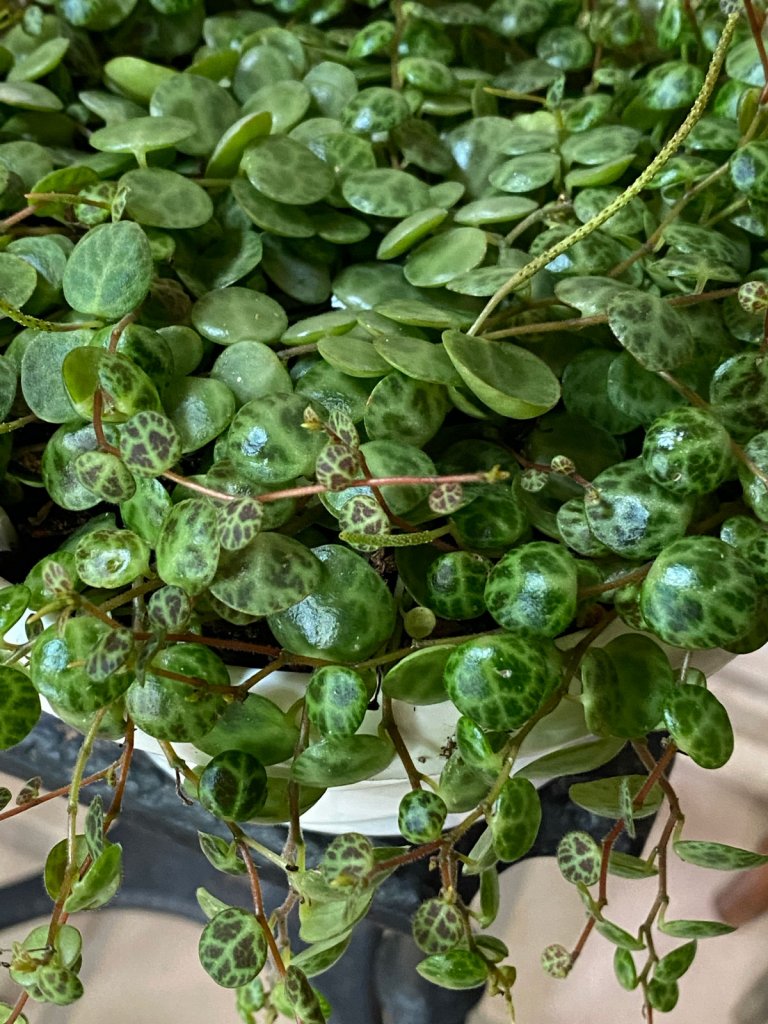
5. TEMPERATURE & HUMIDITY
Average household temperatures and humidity is fine for your String of Turtles, but let’s discuss this topic a bit. I always like to say that if you are comfortable, chances are that your plant will be comfortable too.
Try and maintain temperatures between 65-85F (18-29C). Avoid any minimum temperatures below 55F (13C). Temperatures that are too cold can cause excessive leaf drop. Remember, these are tropical plants and they hate the cold!
Although average indoor humidity is OK for these plants, it will benefit from additional humidity, especially during very dry periods. If you live in a cold-winter area and you run forced air heat, it will be beneficial to run a humidifier.
If you can keep humidity in the 40-60% range, this is great for most indoor plants (as well as our sinuses and skin).
Looking for a good humidifier? Be sure to check out my blog post on my 3 favorite humidifiers.
6. PRUNING AND PROPAGATION
If your plant is getting too long and unkempt for your liking, do not be afraid to trim and prune your plant back lightly. This will keep the plant more vigorous and full, and you can use the cuttings to propagate!
Here are some simple methods that you can use to propagate. Spring and summer are the best times to propagate in general since your plant will be in a phase of most active growth.
Which ever method you choose, don’t place your cuttings in a dark space. Place them wherever you’d normally have your plants growing. Cuttings still need light!
Sphagnum Moss Method
- Snip some cuttings of the plant. Make sure that your cuttings are taken from healthy-looking vines.
- Lay them right on top of moist sphagnum moss.
- Cover the pot loosely with clear plastic wrap, or insert two bamboo stakes or another similar support, and suspect a clear plastic bag over them to provide humidity while the cuttings are rooting.
- Periodically remove the plastic to air things out, let your plant breathe for a few hours and then replace the plastic.
- After cuttings are rooted, you can transfer them to soil.
Water Propagation Method
- Snip some cuttings of the plant. Make sure that your cuttings are taken from healthy-looking vines.
- Remove the lowest leaf or two.
- Place your cuttings in water and make sure that the nodes (where you removed the leaves) are under water.
- Wait for rooting to occur and then plant in potting mix once roots are about half an inch long.
Soil Propagation Method
- Snip some cuttings of the plant. Make sure that your cuttings are taken from healthy-looking vines.
- Remove the lowest leaf or two.
- Insert the cuttings in potting mix and make sure that the nodes (where you removed the leaves) are buried in soil.
- Keep the potting mix moist while rooting and you can also create a humidity dome with a plastic bag as described above.
- Once the cuttings are rooted and you see signs of new growth, you can remove the humidity dome and start your normal care routine.
7. PESTS
String of Turtles are relatively pest free, but if you do encounter any pests, it is likely to be the dreaded mealybug. Mealybugs will appear as white, cottony masses on your plant.
If you do notice mealybugs, use a good insecticidal soap. You can easily purchase a bottle from Amazon and I really like the Bonide Insecticidal Soap.
Always use as directed on the label, spray the entire plant and repeat application even after you don’t see mealybugs anymore to be sure that you eradicated them.
STRING OF TURTLES QUESTIONS AND ANSWERS
Here are some of the most commonly asked questions about Peperomia prostrata.
Can you grow String of Turtles under a lamp or grow light?
Yes absolutely! Any plant can be grown under a grow light.
Is String of Turtles toxic to pets?
According to the ASPCA, String of Turtles is non-toxic to cats and dogs.
Should I cut off the flowers on my String of Turtles?
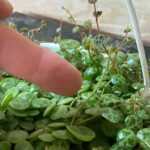
The inflorescences appear as long, narrow, whitish spikes. It is best to cut them off so you can preserve the plant’s energy and so it can focus on growing more foliage. If you enjoy the flowers, there is no harm in leaving them, but make sure to cut them off when they are spent.
Why does my String of Turtles have dry ends?
If you notice that your vines have ends that have shriveled and dried up, immediately check your potting mix. In the vast majority of cases, your plant’s potting mix has completely dried out. Verify this first by checking the potting mix with your finger, and/or lift your pot to see if it’s really light. Give your plant a good watering if it has dried out completely.
Why is my String of Turtles dropping leaves?
Typically, this would be due to two factors. Temperatures that are too cold is one reason. Another reason would be an imbalance in soil moisture. Potting mix that has gone too dry, or stayed too wet, will cause your plant to drop leaves.
Does String of Turtles flower?
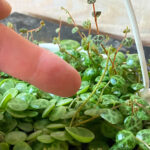
Yes it does! As you can see in the photo, the inflorescence looks like a rat tail. The flowers are actually very tiny and grow on the long inflorescence.
Does String of Turtles grow fast?
Growth rate is relative, and highly dependent on growing conditions. String of Turtles can actually grow pretty quickly under conditions that are to its liking. If you find that growth is very slow, it’s probably due to insufficient light, warmth, poor potting mix, or all of the above.
Why is my String of Turtles not growing?
Mostly likely, you are not providing enough light, period. Providing sufficient light and sufficient attention to potting mix moisture will solve your issues.
Why does my String of Turtles have small leaves?
Although new leaves will be small, if your mature leaves are small and/or thin, you’re likely not providing your plant with enough light. Another indication of low light will be a very slow growth rate and leaves that are more spaced out from each other than they used to be.
Why are my String of Turtles leaves reddish in color?
You may be providing too much direct sun for your plant. Back off a little bit on direct sun, and your plant will turn green again. These plants do not want to be in full, direct sun all day, but they can do well with 2-3 hours of direct sun per day while indoors.
Why are my String of Turtles leaves turning brown and crispy?
Go ahead and feel your potting mix. It is likely that your plant has stayed dried out for much too long.
Why are my String of Turtles leaves turning yellow?
Feel your potting mix. Has your plant stayed wet for too long? Perhaps it Is it sitting in water, is growing in a pot much too large, has poorly draining soil, or any combination of the above. If your plants leaves are yellow and also starting to turn mushy, your plant has been kept wet for too long.
That’s all folks! Do you have a String of Turtles? Comment below. I’d love to hear!

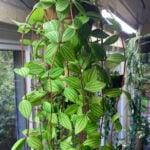
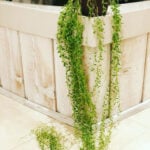




Sam
Monday 6th of November 2023
I have a String of Turtle plant that is less than a year old and it is nearly 4 ft long. Some of the vines have sprouted “fingers” and I can’t find any information about what they are.
Sam
Monday 6th of November 2023
@Raffaele, Hi Raffael,
I don’t think that’s what these are. The “fingers “are growing on the end of the little “string “and have four or five fingers. They almost look like your hand if you were holding a softball with your fingers spread open. Some of the vines actually are continuing to grow out of that cluster a little stems as if they weren’t even there. My plant probably has at least six or eight little clusters of fingers, each at the end of an individual “string“.
Raffaele
Monday 6th of November 2023
Hi Sam! They're probably the inflorescences (the flowering structure). I have a photo in the blog post right above the Temperature and Humidity section. You can see the inflorescence in the upper right hand photo of the picture. Take a look. That's probably what you're referring to :-)
Jessica
Sunday 15th of October 2023
Thank you for the string of turtles article. I could not figure out why my leaves had faded. It grows so well, just faded. I have not fertilized it and the soil has probably lost most of its nutrients. Thanks. I love your page. I get so many great tips besides just basic plant care. I get all the little tips that really help make a plant thrive.
Raffaele
Sunday 15th of October 2023
So glad you're enjoying my site Jessica! :-)
Thays
Monday 4th of September 2023
Excelente articulo, llevo 6 meses con esta planta, aunque la chica que me la vendió me recomendó no regar tan seguido, hice un ajuste en el riego dada las condiciones ambientales de mi casa y ha mejorado creciendo y hasta floreciendo. estamos en verano en España y le ha sentado bien mantener la humedad en su entorno, la tengo en un estante junto a las alocasias y anthurium. Todas son bebes asi que van creciendo a la par.
Raffaele
Tuesday 5th of September 2023
Me alegro que hayas disfrutado el artículo. :-)
Allie
Wednesday 26th of July 2023
Hello! I can’t seem to find advice for my specific problem. My string of turtles has been doing awesome. I got the plant in April 2023 and it was SOAKED. I didn’t water until the top layer of soil was dry. I’ve been only watering when I feel the top layer is dry. It’s getting good light, been growing new leaves and flowering but just today I noticed the lower leaves are dropping like crazy. The leaves are stiff some are normal color and some are more yellow and they have these brown spots, almost like they got too much water? Now the soil is totally dry so I only wet the top layer with a sprayer. I’m not really sure what to do here. I’m not seeing any posts that describe brown spots without the leaves being crispy or mushy. The leaves are neither crispy or mushy.
Raffaele
Thursday 31st of August 2023
Hi Allie! You may have gone too far in the other direction. They don't like to go completely dry either. If you're just using a mister, the soil at the bottom of the pot will stay dry. You'll have to try and strike a balance between the two extremes. That's what I can gather from the information you provided. Good luck! You can always propagate and start a new plant and use a more porous potting mix.
Daphne Andrell
Saturday 22nd of July 2023
when is their dormancy peorid
Raffaele
Saturday 22nd of July 2023
They don't really have one. Though they may slow down in the wintertime if you have short, dark days where you live.